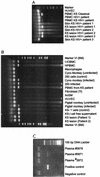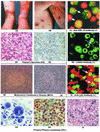Spectrum of Kaposi's sarcoma-associated herpesvirus, or human herpesvirus 8, diseases
- PMID: 12097251
- PMCID: PMC118087
- DOI: 10.1128/CMR.15.3.439-464.2002
Spectrum of Kaposi's sarcoma-associated herpesvirus, or human herpesvirus 8, diseases
Abstract
Human herpesvirus 8 (HHV-8), also known as Kaposi's sarcoma-associated herpesvirus (KSHV), discovered in 1994, is a human rhadinovirus (gamma-2 herpesvirus). Unlike other human herpesviruses (herpes simplex virus, Epstein-Barr virus, varicella-zoster virus, cytomegalovirus, HHV-6, and HHV-7), it is not widespread in the general population and has many unique proteins. HHV-8 is strongly associated with all subtypes of Kaposi's sarcoma (KS), multicentric Castleman's disease, and a rare form of B-cell lymphoma, primary effusion lymphoma. In addition, HHV-8 DNA sequences have been found in association with other diseases, but the role of the virus in these diseases is largely unconfirmed and remains controversial. The seroprevalence of HHV-8, based on detection of latent and lytic proteins, is 2 to 5% in healthy donors except in certain geographic areas where the virus is endemic, 80 to 95% in classic KS patients, and 40 to 50% in HIV-1 patients without KS. This virus can be transmitted both sexually and through body fluids (e.g., saliva and blood). HHV-8 is a transforming virus, as evidenced by its presence in human malignancies, by the in vitro transforming properties of several of its viral genes, and by its ability to transform some primary cells in culture. It is not, however, sufficient for transformation, and other cofactors such as immunosuppressive cytokines are involved in the development of HHV-8-associated malignancies. In this article, we review the biology, molecular virology, epidemiology, transmission, detection methods, pathogenesis, and antiviral therapy of this newly discovered human herpesvirus.
Figures





References
-
- Ablashi, D. V., L. G. Chatlynne, H. C. Cooper, D. A. Thomas, M. Yadav, A. W. Norhanom, A. K. Chandana, V. Churdboonchart, S. A. R. Kulpradist, M. Patnaik, K. Liegmann, R. Masood, M. Reitz, F. Cleghorn, A. Manns, P. H. Levine, C. S. Rabkin, R. Biggar, F. Jensen, P. S. Gill, N. Jack, J. Edwards, J. E. Whitman, and C. Boshoff. 1999. Seroprevalence of human herpesvirus 8 (HHV-8) in countries of Southeast Asia compared to the United States, the Caribbean, and Africa. Br. J. Cancer 81:893-897. - PMC - PubMed
-
- Ablashi, D. V., L. Chatlynne, D. Thomas, D. Bourboulia, M. B. Rettig, R. A. Vescio, D. Viza, P. Gill, R. A. Kyle, J. R. Berenson, and J. E. Whitman, Jr. 2000. Lack of serologic association of human herpesvirus-8 (KSHV) in patients with monoclonal gammopathy of undetermined significance with and without progression to multiple myeloma. Blood 96:2304-2306. - PubMed
-
- Ablashi, D. V., L. Chatlynne, D. Thomas, C.-R. Lee, M. Roman, D. Bourboulia, S. Yoksan, C. Hall, R. Biggar, A. W. Norhanom, T. Yoshikawa, M. Margalith, and J. E. Whitman. 2000. Prevalence of HHV-8 (KSHV) latent and lytic IgG antibody in children: an international study. J. Hum. Virol. 3:261.
-
- Agbalika, F., X. Mariette, J.-P. Marolleau, J.-P. Fermand, and J.-C. Brouet. 1998. Detection of human herpesvirus-8 DNA in bone marrow biopsies from patients with multiple myeloma and Waldenstrom's macroglobulinemia. Blood 91:4393-4394. - PubMed
-
- Alexander, L., L. Denekamp, A. Knapp, M. R. Auerbach, B. Damania, and R. C. Desrosiers. 2000. The primary sequence of rhesus monkey rhadinovirus isolate 26-95: sequence similarities to Kaposi's sarcoma-associated herpesvirus and rhesus monkey rhadinovirus isolate 17577. J. Virol. 74:3388-3398. - PMC - PubMed
Publication types
MeSH terms
LinkOut - more resources
Full Text Sources
Medical

